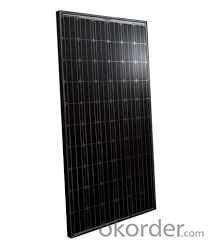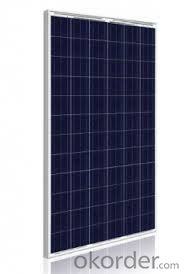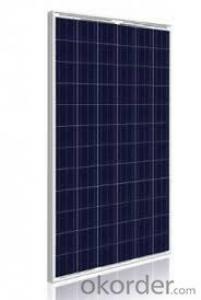235W Poly solar Panel with Factory Directly Sale CNBM
- Loading Port:
- Qingdao
- Payment Terms:
- TT OR LC
- Min Order Qty:
- 10 set
- Supply Capability:
- 300000 set/month
OKorder Service Pledge
OKorder Financial Service
You Might Also Like
Polycrystalline Solar Modules
CNBM offers a range of small, medium and large polycrystalline solar modules, designed for a range of requirements.


Specifications:
Tolerance | +/-3% |
Cell | Polycrystalline silicon solar cells (156 x 156mm) |
N0. of Cells | 60 (10 x 6) |
Dimension of Modules (mm) | 1650 x 990 x 40 |
Weight (kg) | 25.5 |
Limits:
Operating Temperature | -40~+85? |
Storage Temperature | -40~+85? |
Maximum System Voltage | 1000 VDC max. |
Hail Impact | Diameter of 28mm with impact speed |
Temperature and Coefficients:
NOCT | 48C+/-2? |
Voltage temperature coefficient (%/K) | -0.35 |
Current temperature coefficient (%/K) | 0.05 |
Power temperature coefficient (%/K) | -0.45 |
Characteristics:
Model: | SGM-200P | SGM-210P | SGM-220P |
Max-power voltage Vmp (V) | 29.2 | 29.4 | 29.41 |
Max-power current Imp (A) | 6.85 | 7.14 | 7.48 |
Open-circuit voltage Voc (V) | 36.5 | 36.69 | 36.9 |
Short-Circuit Current Isc (A) | 7.28 | 7.6 | 7.93 |
Max-power Pm(W) | 200 | 210 | 220 |
Model: | SGM-230P |
Max-power voltage Vmp (V) | 29.8 |
Max-power current Imp (A) | 7.72 |
Open-circuit voltage Voc (V) | 37.31 |
Short-Circuit Current Isc (A) | 8.19 |
Max-power Pm(W) | 230 |
STC: Irradiance 1000W/m2, module temperature 25?, AM-=1.5
Poly Crystalline Solar Panels Specifications Range
Maximum Power (Pm) | Dimension | Weight | Operating Voltage (Vmp) | Operating Current (Imp) | Open Circuit Voltage (Voc) | Short Circuit Current (Isc) |
0.45W | 140x80x10mm | 0.08kg | 3.3V | 150mA | 4.6V | 160mA |
1.0W | 162x140x10mm | 0.16kg | 7.5V | 150mA | 10.3V | 160mA |
4.5W | 269x251x23mm | 0.8kg | 16.5V | 0.27A | 20.5V | 0.3A |
10W | 420.1×268.9×22.6mm | 1.92kg | 17.5V | 0.58A | 20.5V | 0.6A |
20W | 425x502x50mm | 3.0kg | 16.8V | 1.19A | 21.0V | 1.29A |
30W | 593x502x22.6mm | 3.9kg | 16.8V | 1.78A | 21.0V | 1.94A |
40W | 655x537x50mm | 5.75kg | 17.3V | 2.31A | 22.1V | 2.54A |
50W | 839x537x50mm | 6.0kg | 17.5V | 2.9A | 21.8V | 3.17A |
65W | 1111x502x50mm | 7.2kg | 17.6V | 3.69A | 22.1V | 3.99A |
80W | 1204x537x50mm | 7.7kg | 17.6V | 4.55A | 22.1V | 4.8A |
- Q:How do solar cells perform in urban environments?
- Solar cells can perform well in urban environments, although their efficiency may be slightly reduced compared to rural or open areas due to factors like shading from buildings and pollution. However, advancements in technology and design have made urban solar installations more efficient by utilizing innovative mounting options and optimizing solar panel angles. Additionally, the increasing number of rooftop solar installations in cities has enabled effective utilization of available space and contributed to the growth of renewable energy in urban areas.
- Q:What is the maximum efficiency possible for a solar cell?
- The maximum efficiency possible for a solar cell is currently around 46%.
- Q:Friends are fuel cells are chemical energy into electricity, solar cells are converted into electricity into electricity I would like to know in addition to the structure and the conversion of different ways there are no other differences hope that the specific power of everyone
- building blocks of the scale and installation of flexible, fuel cell power plant area is small, the construction period is short, the power station can be assembled according to the needs of the battery stack, very convenient.
- Q:How do solar cells handle electrical surges or lightning strikes?
- Solar cells are designed to handle small electrical surges or fluctuations in the electrical current, but they are not specifically designed to protect against lightning strikes. In the event of a lightning strike, the solar cells can sustain damage due to the high voltage and current associated with the strike. However, some solar installations include lightning protection systems or surge arresters that can help mitigate the risk of damage caused by lightning strikes.
- Q:What is the expected degradation rate of a solar cell?
- The expected degradation rate of a solar cell can vary depending on various factors such as the quality of materials used, manufacturing processes, environmental conditions, and maintenance practices. However, on average, a well-designed and properly maintained solar cell can experience an annual degradation rate of around 0.5% to 1%. This means that over time, the solar cell's efficiency may decrease by 0.5% to 1% per year.
- Q:What is the lifespan of a solar cell?
- The lifespan of a solar cell can vary depending on various factors such as the quality of the materials used, the manufacturing process, and the operating conditions. On average, most solar cells have a lifespan of around 25 to 30 years. However, with proper maintenance and care, some solar cells can continue to produce electricity for even longer periods.
- Q:How do solar cells perform in areas with high levels of noise pollution?
- Solar cells are not affected by noise pollution as they rely solely on sunlight to generate electricity, making them effective even in areas with high levels of noise pollution.
- Q:How do solar cells perform in dusty environments?
- Solar cells perform less efficiently in dusty environments due to reduced sunlight reaching the surface of the cells. Dust particles can accumulate on the surface of the solar panels, blocking the sunlight and reducing the amount of energy that can be converted. Regular cleaning and maintenance are necessary to ensure optimal performance in dusty conditions.
- Q:Can solar cells be used to power remote oil and gas monitoring systems?
- Yes, solar cells can be used to power remote oil and gas monitoring systems. Solar cells convert sunlight into electrical energy, which can be stored in batteries or used directly to power monitoring systems. This renewable energy source provides a reliable and sustainable solution for remote locations where traditional power infrastructure may be unavailable or costly to install.
- Q:Can solar cells be used for powering outdoor signage?
- Yes, solar cells can be used for powering outdoor signage. Solar panels can convert sunlight into electricity, which can then be used to power various devices including outdoor signage. This is a sustainable and environmentally friendly option, as it reduces dependence on traditional electricity sources and helps to minimize carbon emissions.
1. Manufacturer Overview |
|
|---|---|
| Location | |
| Year Established | |
| Annual Output Value | |
| Main Markets | |
| Company Certifications | |
2. Manufacturer Certificates |
|
|---|---|
| a) Certification Name | |
| Range | |
| Reference | |
| Validity Period | |
3. Manufacturer Capability |
|
|---|---|
| a)Trade Capacity | |
| Nearest Port | |
| Export Percentage | |
| No.of Employees in Trade Department | |
| Language Spoken: | |
| b)Factory Information | |
| Factory Size: | |
| No. of Production Lines | |
| Contract Manufacturing | |
| Product Price Range | |
Send your message to us
235W Poly solar Panel with Factory Directly Sale CNBM
- Loading Port:
- Qingdao
- Payment Terms:
- TT OR LC
- Min Order Qty:
- 10 set
- Supply Capability:
- 300000 set/month
OKorder Service Pledge
OKorder Financial Service
Similar products
New products
Hot products
Related keywords


























